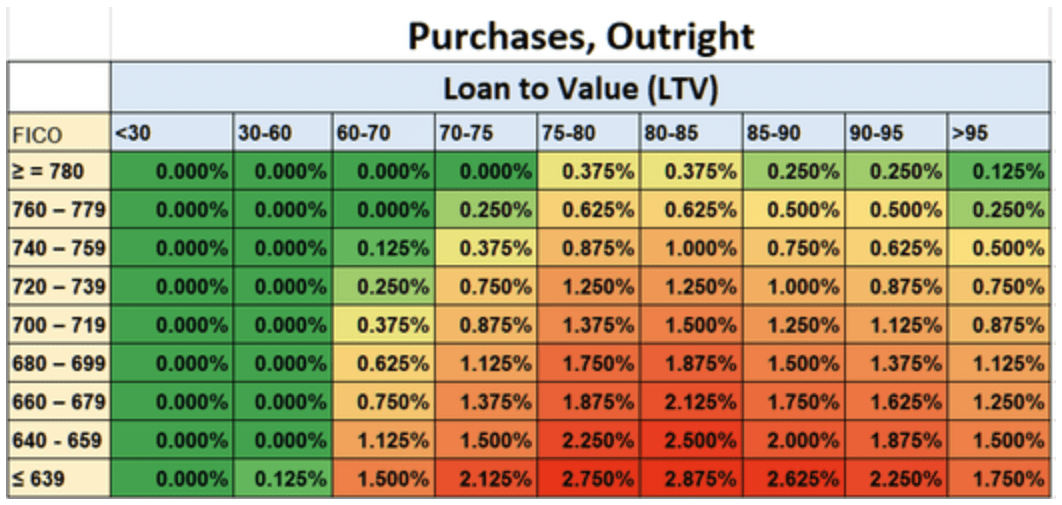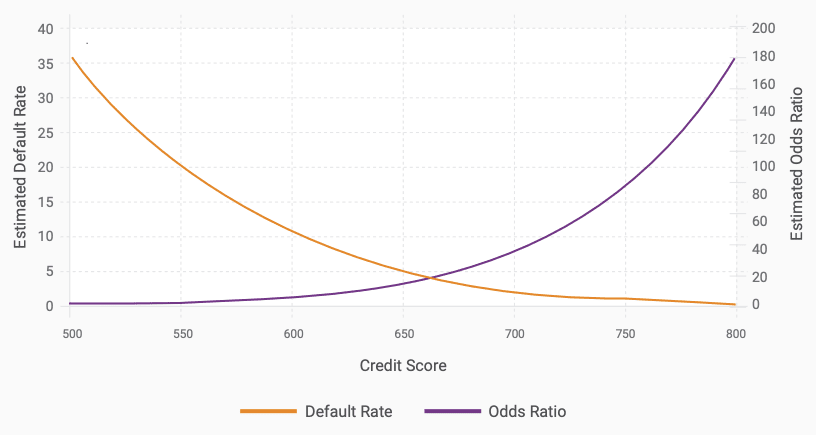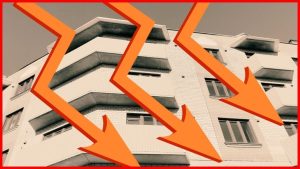
There’s been a lot of alarm in the real estate investment community lately over a newly enacted Federal Housing Finance Agency rule for Fannie Mae and Freddie Mac loans regarding mortgage fees.
The gist of the complaint is that homebuyers with good credit will now have to subsidize those with bad credit. Technically, this is true. However, the way it is being framed is quite misleading. The general argument goes something like this: Those with a 620 FICO score will get a 1.75{ecd1c82889c5dde6baa4cae2f6d3d4c330bac74c2b880dafaca78809ece33a56} discount, and those with a 740 FICO score will pay 1{ecd1c82889c5dde6baa4cae2f6d3d4c330bac74c2b880dafaca78809ece33a56}.
Or another example would be this particularly popular tweet:
?
Homebuyers with credit scores of 680 or higher will pay ~$40 per month more on a home loan of $400,000.
Buyers with down payments of 15{ecd1c82889c5dde6baa4cae2f6d3d4c330bac74c2b880dafaca78809ece33a56} to 20{ecd1c82889c5dde6baa4cae2f6d3d4c330bac74c2b880dafaca78809ece33a56} will get socked with the largest fees.
Buyers with riskier credit ratings and lower down payments will get lower rates and fees. pic.twitter.com/yVEp3btNJg
— Wall Street Silver (@WallStreetSilv) April 19, 2023
While what is said is technically correct, it sounds much worse than it is.
First and foremost, this would only affect Fannie Mae and Freddie Mac loans. This accounts for most loans made to homeowners but would not affect FHA and VA loans nor the non-conforming loans that many investors get.
The fee being discussed here is called the Loan-Level Price Adjustment or LLPA, which predominantly takes into account the borrower’s FICO score and the LTV of the mortgage. To a lesser extent, it also takes into account whether the property is owner-occupied or not, if it’s a condo or single-family residence, whether it’s a second or first mortgage, and if there is any cash-out on a refinance.
The LLPA fee is then effectively added to the mortgage. So, for example, if the mortgage is $100,000 and has a 1{ecd1c82889c5dde6baa4cae2f6d3d4c330bac74c2b880dafaca78809ece33a56} LLPA, the LLPA would be $1,000. This could be paid as a fee but is more often absorbed by the lender in exchange for a higher interest rate on the loan.
This added cost on the mortgage is to cover Fannie Mae and Freddie Mac from the added risk of lending to riskier borrowers.
Riskier Borrowers Are Still Paying More
The mistake being made by many here is that the percentages given are the changes, not the totals. Well, not quite even that. The 1{ecd1c82889c5dde6baa4cae2f6d3d4c330bac74c2b880dafaca78809ece33a56} fee mentioned is what someone with a 740 FICO score would pay if they are taking out an 80-85{ecd1c82889c5dde6baa4cae2f6d3d4c330bac74c2b880dafaca78809ece33a56} LTV loan. The 1.75{ecd1c82889c5dde6baa4cae2f6d3d4c330bac74c2b880dafaca78809ece33a56} “discount” is not the fee someone with a 620 FICO score would pay, but instead the reduction in that fee from before. And in this case, it is for someone taking out a 95{ecd1c82889c5dde6baa4cae2f6d3d4c330bac74c2b880dafaca78809ece33a56} LTV loan or higher.
Before this rule was passed, the LLPA fee for someone with a 620 FICO score taking out a 95{ecd1c82889c5dde6baa4cae2f6d3d4c330bac74c2b880dafaca78809ece33a56} loan was 3.5{ecd1c82889c5dde6baa4cae2f6d3d4c330bac74c2b880dafaca78809ece33a56}. Now it is 1.75{ecd1c82889c5dde6baa4cae2f6d3d4c330bac74c2b880dafaca78809ece33a56} (a 1.75{ecd1c82889c5dde6baa4cae2f6d3d4c330bac74c2b880dafaca78809ece33a56} reduction). Here is a chart from Mortgage News Daily showing the effects the changes of this rule would have on loans for borrowers depending on the LTV and FICO score.
And here are the actual rates people would pay.

As Mortgage News Daily sums up,
“As you can now plainly see, if you have a score of 640, you’ll be paying significantly more than if you had a 740. Using an 80{ecd1c82889c5dde6baa4cae2f6d3d4c330bac74c2b880dafaca78809ece33a56} loan-to-value ratio as an example, your LLPA at 640 is 2.25{ecd1c82889c5dde6baa4cae2f6d3d4c330bac74c2b880dafaca78809ece33a56} versus 0.875{ecd1c82889c5dde6baa4cae2f6d3d4c330bac74c2b880dafaca78809ece33a56} for a 740 score. That’s a difference of 1.375{ecd1c82889c5dde6baa4cae2f6d3d4c330bac74c2b880dafaca78809ece33a56}, or just over $4000 on a $300k mortgage. This is almost half the previous difference, and that’s certainly a big change.”
In fact, this rule change was made back on January 1, 2023, and only came into effect now. Here is the announcement from the Federal Housing Finance Agency, and here is the full loan-level price adjustment matrix from Fannie Mae itself.
The long and short story of it is, however, that those with low credit will still pay more than those with high credit. The real estate world has not been put completely upside down.
Is it Still a Subsidy for Those with Low Credit?
At the beginning of this article, I said this new rule still involved those with good credit subsidizing those with bad. Given those with good credit still pay less, how is that so?
The reason is that those with low credit scores are much more likely to go into default than those with good credit. And the difference is probably bigger than most people realize.
For example, a white paper from FICO concluded their model showed that “at a score of 800, we expect approximately 180 borrowers to consistently pay their loans on time for every one borrower that defaults. This compares quite favorably to consumers with a score of 600, where one out of every 11 borrowers is expected to have payment problems.”
Overall, this was the relationship they found between FICO scores and mortgage default rates was as follows:

Another paper found that between 2000 and 2002, those with a FICO score of 750 or more had a probability of default of just 1{ecd1c82889c5dde6baa4cae2f6d3d4c330bac74c2b880dafaca78809ece33a56}, whereas those with a score of 600-649 had a default rate of 15.8{ecd1c82889c5dde6baa4cae2f6d3d4c330bac74c2b880dafaca78809ece33a56}, and those under 500 had a default rate of a whopping 41{ecd1c82889c5dde6baa4cae2f6d3d4c330bac74c2b880dafaca78809ece33a56}. Similar results were found in another study by the SEC of mortgages taken out between 1997 and 2009.
The general result should not be surprising, although the size of the discrepancy might be too many (Does the 2008 financial crisis make a little more sense now?).
The LLPA is meant to cover some of this added risk. But from just eyeballing the chart above, it would appear that even the old LLPAs were a bit generous (especially given the average loss a bank takes on a mortgage that gets foreclosed on is something like 40{ecd1c82889c5dde6baa4cae2f6d3d4c330bac74c2b880dafaca78809ece33a56}). Reducing the LLPA for risky borrowers is likely going to increase the costs to Fannie and Freddie even more so. And as basic economics would indicate, that loss would need to be made up for by increasing rates across the board, including on borrowers with high credit ratings.
Thus, it is true this rule is likely to mean that borrowers with high credit ratings will be subsidizing those with low ratings.
But no, the outrage clickbait headlines are false. Borrowers with low credit ratings will not be paying less than borrowers with high credit ratings. And it’s important to be precise about what exactly is happening.
Find a Lender in Minutes
A great deal doesn’t sit around. Quickly find a lender who specializes in investor-friendly loans that are right for you and your investment strategy.
Note By BiggerPockets: These are opinions written by the author and do not necessarily represent the opinions of BiggerPockets.






